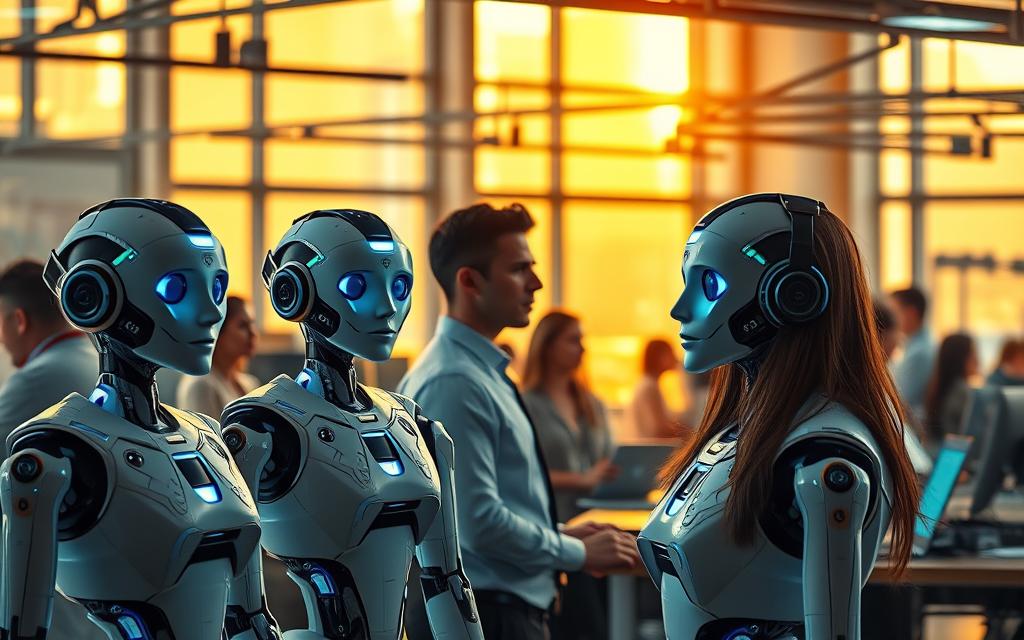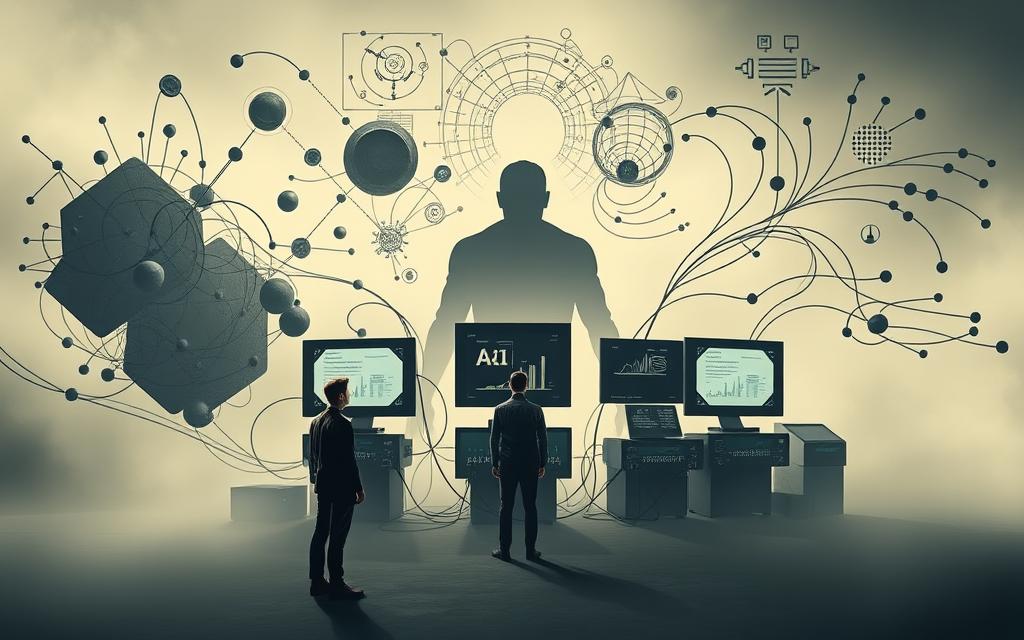Table of Contents
Modern enterprises face rapid changes driven by advanced technologies. Among them, artificial intelligence stands out as a game-changer. Companies worldwide now integrate AI to streamline workflows, enhance decision-making, and boost efficiency.
The global AI market is projected to grow at a staggering 38.1% CAGR from 2022 to 2030. This surge reflects its expanding role across industries like healthcare, retail, and finance. Businesses leveraging these tools gain a competitive edge through automation and predictive insights.
Beyond productivity, ethical considerations emerge. Workforce dynamics shift as repetitive tasks become automated. However, strategic implementation creates opportunities for innovation and economic growth.
This transformation reshapes operational models. Forward-thinking leaders recognize AI’s potential to redefine customer experiences and market strategies. The future promises even deeper integration, merging human expertise with AI-driven solutions.
AI’s Transformative Role in Modern Business
Over 75% of firms already integrate AI tools to stay competitive. This shift spans industries, from diagnosing diseases to personalizing shopping experiences. Adoption rates reveal a stark divide: developed nations lead, while emerging markets lag due to infrastructure gaps.
The Rise of AI Adoption Across Industries
Healthcare sees 38% of providers using AI for diagnostics, reducing human error. Banks project $1 billion in added value by 2035 through fraud detection algorithms. Retail’s AI market will hit $20 billion by 2026, driven by hyper-personalized ads.
Construction firms report 50% productivity jumps via predictive maintenance. Yet implementation costs remain high, especially for SMEs. Deloitte’s mining study highlights AI’s edge—processing geological data 18x faster than traditional methods.
Key Statistics: AI’s Growing Business Impact
Cybersecurity tools dominate usage (51%), followed by digital assistants (47%). Labor productivity could rise by 1.5 percentage points annually. Samsung’s Galaxy S24 Ultra showcases consumer-facing AI, like real-time photo edits.
Transparency is critical—85% of customers demand clarity on AI assurance practices. Regional disparities persist: North America invests heavily, while Africa’s adoption hinges on cheaper cloud solutions.
How Does Artificial Intelligence Affect Business Efficiency?
Time-consuming manual processes now take minutes with smart automation. Companies leverage these tools to cut costs, reduce errors, and accelerate workflows. From invoice processing to equipment monitoring, the impact is measurable.

Streamlining Repetitive Tasks
Procurement and accounting teams save 15+ hours weekly through automated approvals. AI handles 80% of invoice matching in platforms like QuickBooks, reducing human oversight. TD Bank’s mortgage renewal system uses chatbots to process 90% of routine queries without staff.
Data-Driven Decisions at Scale
Machine learning crushes traditional methods in speed and accuracy. For example, mining firms analyze geological data 18 times faster than manual reviews. HubSpot’s CRM suggests email responses by predicting client needs, slashing drafting time by 50%.
| Process | Human Speed | AI Speed |
|---|---|---|
| Invoice Processing | 10 min per document | 45 seconds |
| Equipment Diagnostics | 24–48 hours | Real-time alerts |
Healthcare systems could save $150 billion yearly by automating claims. Flybits’ banking tools personalize offers using location data, boosting customer engagement by 30%.
AI Applications Across Key Industries
From hospitals to shopping aisles, advanced technologies reshape core operations. These tools deliver measurable improvements in accuracy, speed, and cost-efficiency. Leaders who adopt them gain unmatched competitive advantages.
Healthcare: Diagnostics and Patient Care
Johns Hopkins employs AI-powered surgical systems, reducing procedure times by 30%. Mayo Clinic’s diagnostic algorithms achieve 94% accuracy in detecting early-stage cancers. Such advancements cut wait times and improve outcomes.
Drug discovery now takes months instead of years. Machine learning models analyze genetic data to predict treatment responses. This accelerates breakthroughs for rare diseases.
Banking: Fraud Detection and Customer Personalization
Bank of America’s Erica handles 50 million client queries monthly. Its fraud detection tools save $1 billion annually by flagging suspicious transactions. Personalized financial advice boosts customer satisfaction by 25%.
Real-time credit scoring allows instant loan approvals. AI scans spending patterns to offer tailored products. This drives engagement while minimizing risks.
Retail: Hyper-Personalization and Inventory Management
Nike’s demand forecasting system reduces overstock by 20%. Zara’s AI tracks real-time sales to optimize inventory. Shelf-stocking robots at Walmart cut labor costs by 15%.
Recommendation engines increase average order values by 35%. Chatbots resolve 80% of routine inquiries, freeing staff for complex issues. These applications redefine retail efficiency.
AI in Fraud Detection and Cybersecurity
Financial institutions lose billions annually to fraudulent activities, but AI-powered solutions are changing the game. These systems analyze patterns in real-time, slashing false positives by 40%. From banking to retail, proactive threat mitigation is now achievable.
Real-Time Threat Identification
JP Morgan’s COiN platform reviews 12,000 documents in seconds, flagging discrepancies instantly. Behavioral biometrics track typing speed and mouse movements to spot imposters. Mastercard’s network blocks $20 billion in fraud yearly by learning from global transaction data.
Darktrace’s Enterprise Immune System mimics human antibodies, neutralizing threats autonomously. Such algorithms adapt faster than rule-based tools, cutting response times by 80%.
Reducing Financial Risks
AI automates SEC compliance, scanning millions of filings for red flags. Palantir predicts money laundering routes by mapping hidden connections. Insurers use machine learning to slash fraudulent claims by 35%, saving $6 billion annually.
| Method | Detection Speed | Accuracy |
|---|---|---|
| Traditional Rules | Hours–Days | 72% |
| AI-Powered Systems | Seconds | 94% |
For retailers, AI-powered fraud detection systems analyze purchase histories to block stolen credit cards. As threats evolve, these tools remain indispensable for management teams worldwide.
Revolutionizing Customer Service with AI
Modern enterprises now leverage smart technologies to transform how they interact with clients. Over 64% of businesses report significant improvements in customer service after adopting AI-driven solutions. These tools reduce wait times, personalize interactions, and boost satisfaction rates.

Chatbots and 24/7 Support
Amtrak’s virtual assistant handles 5 million inquiries yearly, saving $1 million in labor costs. Unlike traditional call centers, AI-powered chatbots operate non-stop. They resolve common issues like password resets or order tracking instantly.
Platforms like Zendesk and Intercom use machine learning to improve response accuracy. Sephora’s reservation bot increased bookings by 11% through seamless scheduling. These applications free human agents for complex cases, enhancing efficiency.
| Platform | Query Resolution Rate | Cost Savings |
|---|---|---|
| Amtrak Chatbot | 85% | $1M/year |
| Zendesk AI | 78% | 30% lower support costs |
Sentiment Analysis for Improved Engagement
Salesforce Einstein detects frustration in emails, prompting urgent responses. Coca-Cola’s social listening AI analyzes 650,000 posts monthly to gauge brand perception. Such analysis boosts retention by 22% through proactive issue resolution.
Telecom firms cut response times by 40% using real-time mood detection. However, ethical debates arise around emotion tracking. Transparent policies ensure trust while maximizing engagement benefits.
For deeper insights, explore AI-driven customer experience innovations shaping modern service standards.
AI and the Future of Work
By 2025, automation could displace 16% of U.S. jobs while generating 9% new positions. This shift demands strategic workforce planning across industries. 60% of SMB leaders now prioritize AI skills when hiring, signaling changing competency requirements.

Job Displacement vs. Creation
Manufacturing faces the highest automation risk, with 25% of tasks replaceable by machines. Creative sectors show more resilience, requiring human judgment for innovation. MIT’s human-AI collaboration framework demonstrates how blended teams achieve 40% higher productivity than either alone.
Key industry contrasts:
- Assembly line workers risk displacement without retraining
- Graphic designers gain efficiency through AI-assisted tools
- Healthcare practitioners enhance diagnostics with machine learning
Upskilling for an AI-Augmented Workforce
Major corporations are investing heavily in workforce transition programs. Amazon’s $700 million upskilling initiative has retrained 300,000 employees since 2019. IBM’s SkillsBuild platform reaches 7 million learners globally with free AI courses.
Effective strategies include:
- Accenture’s responsible AI training for 500,000 staff
- Ethical certification programs from IEEE and CompTIA
- STEM education partnerships with community colleges
These efforts help workers transition into emerging roles like AI trainers and ethics auditors. The future workplace will value adaptability as much as technical skills.
Ethical Considerations in AI Implementation
Algorithmic bias cases have sparked global debates about responsible deployment. Over 85% of Americans now support national safety initiatives for these systems. The EU AI Act’s risk-based approach sets a precedent for governance worldwide.

Bias and Transparency Challenges
ProPublica’s COMPAS study revealed racial disparities in criminal sentencing algorithms. The tool falsely flagged Black defendants as high-risk twice as often as white defendants. Such cases underscore the need for rigorous bias testing.
IBM’s AI Fairness 360 toolkit helps developers audit models for:
- Demographic parity in loan approvals
- Equal error rates across gender groups
- Transparent feature weighting
Microsoft’s Responsible AI Standard mandates diversity audits costing $15,000–$50,000 per model. These checks prevent skewed outcomes in hiring or credit scoring.
Regulatory and Privacy Concerns
California’s Consumer Privacy Act (CCPA) grants users rights to access AI-processed data. GDPR’s “right to explanation” requires companies to disclose automated decision logic. Non-compliance fines exceed €20 million under EU rules.
| Region | Key Regulation | High-Risk Applications |
|---|---|---|
| EU | AI Act (2025) | Biometrics, critical infrastructure |
| US | Algorithmic Accountability Act | Healthcare, financial services |
Banking management teams now face 72-hour breach reporting deadlines. As ethical frameworks evolve, businesses must balance innovation with accountability.
The Economic Impact of AI on Businesses
Global economies are transforming as AI reshapes productivity and market dynamics. By 2030, these technologies could add $15.7 trillion to worldwide GDP, according to PwC research. This growth stems from operational efficiencies and new revenue streams across sectors.
Productivity Gains and Cost Savings
McKinsey estimates AI could unlock $6 trillion annually in productivity gains. Manufacturing leads with 40% faster assembly lines using computer vision. Logistics firms like FedEx report 25% fuel savings through AI-optimized routes.
Key economic benefits include:
- Nvidia’s market cap grew 240% in 2023 amid AI chip demand
- SMEs adopting AI tools see 18% higher output per employee
- R&D tax credits boost AI investment returns by 15-20%
“AI-driven automation isn’t just cutting costs—it’s creating entirely new business models.”
Risks of Market Monopolization
The IMF warns that top 1% companies capture 80% of AI-related profits. Antitrust cases against major tech firms highlight concerns over data control. Smaller businesses face adoption barriers due to:
| Challenge | Enterprise Solution | SME Reality |
|---|---|---|
| Implementation Costs | Dedicated AI budgets | Limited cloud credits |
| Talent Acquisition | In-house ML teams | Freelance contractors |
Policy proposals aim to balance this disparity. The EU’s Digital Markets Act now regulates AI platform dominance. Meanwhile, emerging markets show slower adoption—only 12% of African firms use advanced automation versus 63% in North America.
As AI matures, its economic influence will expand beyond productivity metrics. Strategic investments and fair access policies will determine which companies thrive in this new landscape.
Future Trends: Where AI Is Headed Next
The next wave of innovation will redefine how systems interact with our world. From self-optimizing factories to AI-driven urban planning, these technologies promise transformative applications. Markets reflect this shift—agentic AI alone could hit $73 billion by 2032.
Agentic AI and Autonomous Workflows
Boston Dynamics’ humanoid robots now handle warehouse logistics with 99% precision. Siemens’ autonomous factories use AI to predict equipment failures 48 hours in advance. Key advancements include:
- Self-learning algorithms that adapt without human input
- Nvidia’s Omniverse, adopted by 500+ firms for real-time 3D simulations
- Edge computing investments surging 42% yearly for faster decision-making
“Agentic AI represents the third era of automation—systems that don’t just execute tasks but reason about them.”
Integration with IoT and 3D Environments
Smart cities now sync traffic lights with weather systems, reducing congestion by 30%. Unity’s AI tools let architects test building designs in virtual environments before construction. Notable trends:
- AI-powered IoT deployments growing at 42% CAGR through 2028
- Walmart’s shelf-scanning drones cutting inventory checks from 30 days to 24 hours
- AI-driven energy grids dynamically balancing supply across 15 U.S. states
These future developments signal a move toward fully interconnected technologies. As boundaries between physical and digital dissolve, businesses must prepare for a world where AI orchestrates entire ecosystems.
Conclusion
Sustainable progress meets innovation as AI reshapes modern enterprises. Balancing efficiency with ethics remains critical—93% of environmental goals now seem achievable through responsible deployment.
Every sector faces unique transformation. Healthcare gains precision, retail thrives on personalization, and manufacturing boosts output. Workforce adaptation is essential, with upskilling bridging the talent gap.
The future demands strategic roadmaps. Gartner’s hype cycle shows AI maturing from experiment to core strategy. Companies embracing this shift will lead in growth and operational excellence.
Competitive advantage hinges on one truth: AI is no longer optional. The winners will be those who harness its impact responsibly today.
FAQ
What industries benefit most from AI integration?
Healthcare, banking, and retail see significant advantages. AI improves diagnostics, fraud detection, and personalized shopping experiences.
Can AI improve fraud detection in financial services?
Yes. Machine learning analyzes transactions in real time, flagging suspicious activity faster than traditional methods.
How does automation impact workforce productivity?
By handling repetitive tasks, AI frees employees for strategic work, boosting efficiency by up to 40% in some sectors.
What risks come with AI-powered customer service tools?
Over-reliance on chatbots may reduce human interaction. However, sentiment analysis ensures responses stay empathetic and accurate.
Will AI replace jobs across multiple sectors?
While some roles evolve, AI creates new opportunities in data science, cybersecurity, and system maintenance, demanding workforce upskilling.
What ethical challenges arise with business AI adoption?
Bias in algorithms and data privacy concerns require transparent model training and compliance with regulations like GDPR.
How does predictive analytics optimize inventory management?
Retailers use demand forecasting algorithms to reduce overstock by 20-50%, cutting costs while improving shelf availability.
Can small businesses compete with AI-driven corporations?
Cloud-based AI tools level the playing field, offering affordable solutions for marketing automation and customer insights.
What emerging AI trends should businesses watch?
Autonomous workflow systems and AI-IoT integration will redefine smart manufacturing and logistics within 3-5 years.









